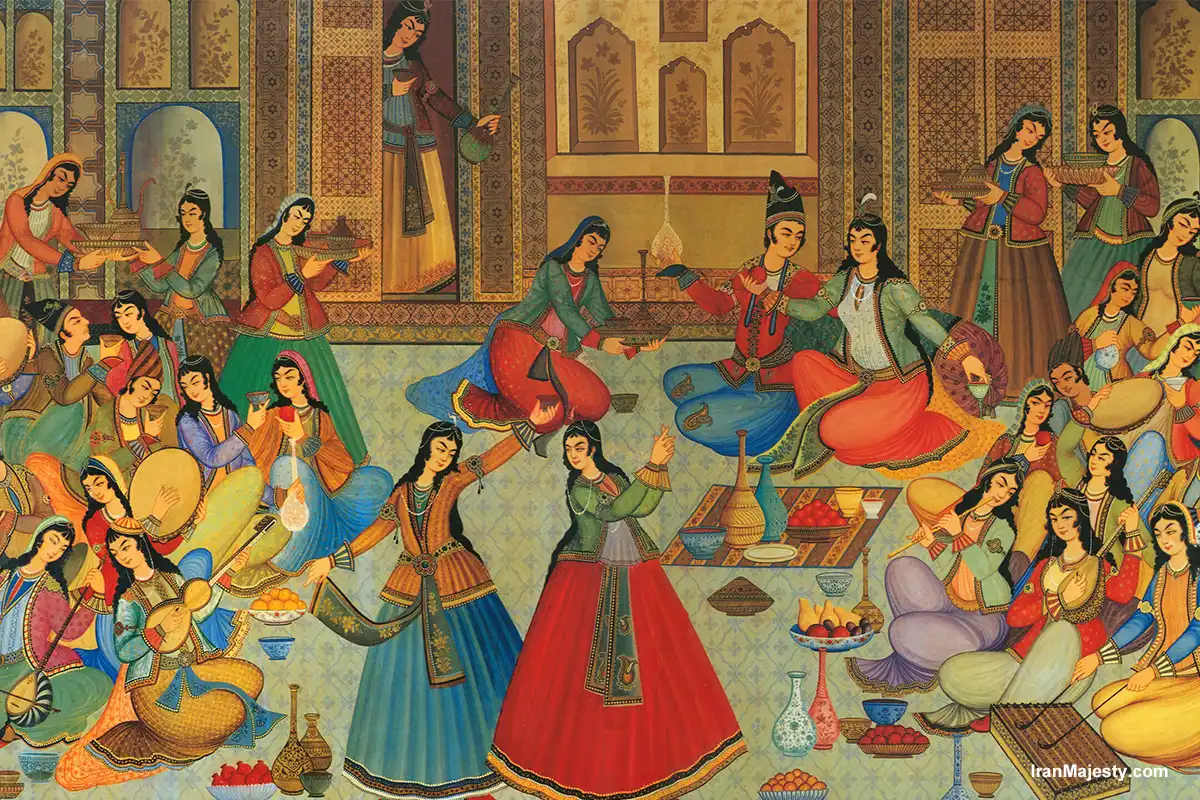Persian Festivities: Iran is a land of ancient culture, with deep-rooted traditions that are still celebrated in modern times. The celebrations in Iran offer a glimpse into the richness of Persian culture, its emphasis on family, and its connection to the natural world. In this post, we’ll explore some of the most popular and cherished celebrations in Iran, each with unique customs, foods, and activities that make them special.
Nowruz (Persian New Year)
One of Iran’s most famous and widely celebrated holidays, Nowruz marks the beginning of the Persian New Year and the arrival of spring. Celebrated on the spring equinox, Nowruz has ancient Zoroastrian origins and is observed by millions across Iran and other parts of Central Asia.
- Customs and Traditions: Families set up a “Haft-Seen” table with seven symbolic items, each beginning with the Persian letter “S” and symbolizing different virtues like rebirth, beauty, and patience.
- Celebrations: People clean their homes, wear new clothes, and visit family and friends. Fireworks, traditional music, and dances are a common sight.
- Special Foods: Sabzi Polo Mahi (herbed rice with fish) is traditionally served, along with sweets like baklava and dried nuts.
Nowruz is an enchanting holiday that showcases the unity of Iranians and their respect for renewal and nature.
“This video from SAT-7 UK sheds light on Celebrations in Iran: A Look at Persian Festivities and Traditions in an engaging way. Included here for your enrichment, with credit to the original creator for their excellent production.”

Chaharshanbe Suri (Festival of Fire)
Celebrated on the eve of the last Wednesday before Nowruz, Chaharshanbe Suri is a festival rooted in Zoroastrianism and dedicated to cleansing and purification.
- Customs and Traditions: People jump over bonfires chanting, “Zardi-ye man az toh, sorkhi-ye toh az man,” meaning “Take away my paleness and give me your redness.” This symbolizes a wish for health and happiness.
- Celebrations: The evening is filled with bonfires, firecrackers, and festivities that involve family gatherings.
Chaharshanbe Suri is a thrilling festival that showcases the adventurous spirit of Iranians as they prepare for the Persian New Year.
Yalda Night (Shab-e Yalda)
Shab-e Yalda, or Yalda Night, is celebrated on the longest night of the year, which falls on the winter solstice. This festival traces back to ancient Persia when people worshiped Mithra, the god of light.
- Customs and Traditions: Families gather to recite poetry, often by the famous Persian poet Hafez, and enjoy a night of storytelling.
- Special Foods: Watermelon, pomegranate, and nuts are traditional treats that symbolize light and warmth to ward off the dark winter.
Yalda Night offers a warm and cozy celebration focused on family, poetry, and the beauty of togetherness during winter’s longest night.
Cyrus the Great Day
Celebrated on October 29th, Cyrus the Great Day honors the memory and legacy of Cyrus the Great, the founder of the Achaemenid Empire and a symbol of Iranian pride. Cyrus is celebrated for establishing one of the world’s first human rights documents, known as the Cyrus Cylinder.
- Traditions: Iranians commemorate this day with gatherings, discussions, and sometimes ceremonies held at the Tomb of Cyrus in Pasargadae.
This day offers an opportunity to reflect on the values of justice, tolerance, and unity championed by one of history’s most admired leaders.
Pomegranate Festival
Celebrated in autumn, the Pomegranate Festival is dedicated to one of Iran’s most cherished fruits, the pomegranate, which symbolizes love, fertility, and abundance.
- Traditions: During this festival, Iranians gather to taste fresh pomegranates and pomegranate-based products like syrups and jams. Local markets and bazaars often hold events, offering pomegranate tastings and displays.
- Celebrations: Some areas host special events, including music and dance, to celebrate the harvest.
The Pomegranate Festival is a delicious and joyful celebration that showcases Iran’s agricultural heritage.
Ashura
Ashura is one of the most significant religious observances in Iran, especially for those of the Shia Muslim faith. It commemorates the martyrdom of Imam Hussein, the grandson of Prophet Muhammad, at the Battle of Karbala.
- Customs and Traditions: Many people participate in processions, attend religious ceremonies, and prepare special meals for the community.
- Celebrations: The event is marked with prayers, recitations, and symbolic reenactments to honor Imam Hussein’s sacrifice and bravery.
Ashura is a solemn but important day that highlights the values of sacrifice, courage, and faith.
Mehregan (Festival of Mehr)
Mehregan is an ancient Persian festival of friendship, love, and gratitude that dates back to Zoroastrian times. Celebrated in autumn, Mehregan is named after Mehr, the goddess of love and light.
- Customs and Traditions: Families decorate their homes, wear colorful clothes, and prepare a table with items that represent prosperity and gratitude.
- Special Foods: Dishes like stews and rice, along with sweet treats, are enjoyed to celebrate the bounty of the season.
Mehregan is an uplifting celebration that mirrors the values of thankfulness and love shared across Iranian culture.
Sizdah Bedar (Nature Day)
Sizdah Bedar is celebrated on the thirteenth day of Nowruz, marking the end of the New Year festivities. Iranians take this day as an opportunity to connect with nature and enjoy the great outdoors.
- Customs and Traditions: Families and friends have picnics in parks or countryside areas, playing games, eating together, and spending time in nature.
- Special Ritual: A custom on Sizdah Bedar is to throw “Sabzeh,” green sprouts grown for the Haft-Seen, into flowing water, symbolizing a fresh start and letting go of negativity.
Sizdah Bedar is a joyful day of relaxation and unity with nature, showing the Iranian love for the outdoors and new beginnings.
Golabgiri (Rosewater Festival)
In the picturesque town of Kashan, the Golabgiri, or Rosewater Festival, is celebrated annually during spring when roses bloom.
- Customs and Traditions: Visitors can watch the rosewater-making process and enjoy the fragrant aroma that fills the air. Local crafts and rose-based products are also on display.
- Celebrations: The festival involves traditional music, dancing, and storytelling that showcase the cultural heritage of the region.
Golabgiri offers visitors a unique experience to see the traditional rosewater production and enjoy the scenic beauty of Kashan.
Ancient Zoroastrian Festivals: Sadeh
Sadeh is another ancient Zoroastrian festival celebrated 50 days before Nowruz. It marks the end of winter and celebrates the discovery of fire, an essential element in Zoroastrianism.
- Customs and Traditions: Large bonfires are lit to symbolize the triumph of light over darkness and the warmth over the cold of winter.
Sadeh is a fascinating glimpse into one of the oldest religious traditions in Iran, filled with symbolism and reverence for fire.
An Invitation to Discover Iran’s Festivals
Iran’s celebrations reveal a profound respect for history, religion, and nature. From the vibrant Nowruz to the warm gatherings on Yalda Night, each festival in Iran offers unique experiences and cultural insights. These celebrations provide an opportunity to appreciate the rich heritage, unity, and joy that connect Iranians.
Are you curious to experience these celebrations firsthand? Iran welcomes visitors to explore its cultural festivals, which are filled with welcoming communities, age-old traditions, and the enchanting beauty of Persian customs.
If you enjoyed this post or have questions about Iran’s festivals, feel free to leave a comment below! Don’t forget to share this article with friends who would love to know more about Iran’s cultural wonders.


0 Comments